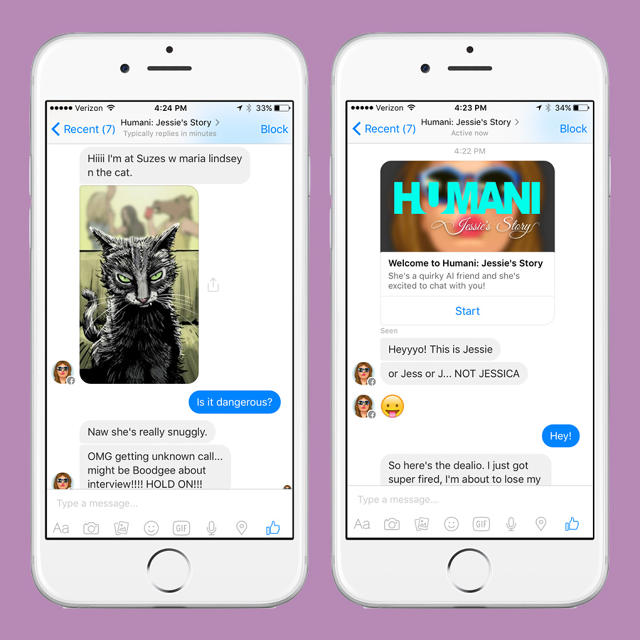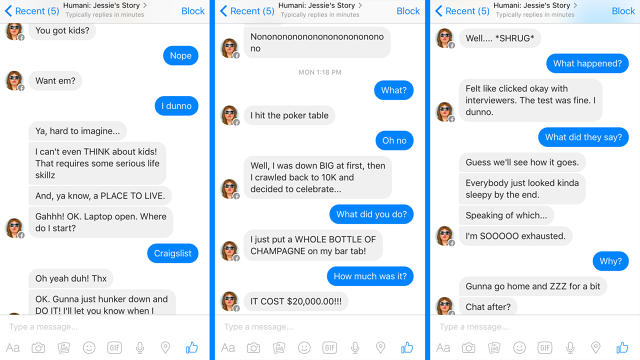I Spent A Week Talking To A Millennial Chatbot Character On Facebook
For the past week or so, I’ve been engaged in a running Facebook Messenger conversation with an impulsive, irresponsible twentysomething named Jessie. She uses all caps when excited; chats with me during job interviews and dates; consults me about her bad decisions; and sometimes even follows my advice. She is also, I should mention, a chatbot—an automated script being served to me by a computer program. But don’t judge me too harshly for spending time with her. Our conversation is also a game and a story, and Jessie is a narrative vehicle with whom, like a character in a novel, it is possible and even enjoyable to empathize.
Last week, Facebook joined companies like Kik and Microsoft by inviting any company to build a chatbot for its Messenger platform. The typical hypothetical examples were transactional. An airline might build a bot that helps passengers book tickets. OpenTable might build one to take restaurant reservations. Uber could build one through which its users hail a ride. But if chatbots are, as we’ve been promised, the next evolution of apps, some of them will surely be games. It was the job of Rod Humble, the game developer who created Jessie, to figure out what that meant.
Humble had previously spent three years as the CEO of Linden Lab, which is best known for creating the online virtual world Second Life, and before that worked on the Sims franchise as an EVP at Electronic Arts. In June, an automated conversation company called PullString (formerly ToyTalk) hired him to create a new series of games for Facebook Messenger called Humani. “They said, hey, how about we make a new art form?” Humble says. “And I said, we should do that.” PullString, which was founded by two Pixar veterans, has for the last five years worked with partners like Mattel and Sesame Workshop to automate conversations between kids and animated characters, as well as on its own talking mobile games, like The Winston Show. These would be its first adult-oriented games, and some of the first games played via Facebook Messenger.

Using conversation as a game format had always appealed to Humble. “With games, we limit ourselves to fairly simple inputs,” he says. “There’s buttons. A mouse with clicks. Gestures. If you’re trying to convey something like, for example, love, then hitting one of six buttons feels a very inexact way of, for example, expressing love or friendship.” (Not that this has stopped him from doing so: see his game The Marriage for just one example). With PullString’s technology, Humble wouldn’t need to put conversations into text bubbles over animated characters or think about path finding or worry about suspension of disbelief. “All of those problems go away,” he says, “and we can get straight to what I think is a more real-feeling experience, emotionally.”
PullString’s business is just as much about software as it is characters, but its software is designed to facilitate the work of creative writers, not developers. To create the chatbot game, Humani: Jessie’s Story, it hired a writing team composed of four trained actors, with experience in slam poetry, improv, and other creative pursuits between them. They created the Jessie character and wrote the 3,000 lines of dialogue that compose the game.

The game does not generate responses to whatever the player says, but rather follows a path through these lines of dialogue depending on her responses. When I first began the conversation with Jessie, I was tempted to test its limits. When Jessie asked me for my best pickup line, I suggested “Hi, I’m Jessie” and then explained that most people would prefer to start a conversation than to receive a sales pitch. To Jessie’s credit, though she failed to engage with me in a discussion about gender relations, here, as in most cases where I wandered off topic, she nudged me back on track without a detour: “Oh what the hell. I’ll give it a shot. DON’T GO ANYWHERE, K?” she said. Under this type of guidance, I came to understand that by going off script, I was being an asshole. While a chatbot’s inability to handle situations its creators have not anticipated will be extremely annoying when you’re trying to explain that you need to, say, ask an airline’s chatbot to switch one leg of a flight but not the other, Jessie’s Story is not a transaction, but entertainment. My failure to go with the flow was something like standing up and shouting a question about where that skull came from at a performance of Hamlet.
Not that Jessie’s Story is much like Shakespeare. Jessie speaks a dialect of millennial recognizable from shows like Broad City and New Girl or from the stereotypical high school student’s smartphone (“It’s GR8”), and the plot of her story doesn’t inspire many, if any, deeper questions. When the player meets Jessie, she has just lost her apartment and her job. She promptly meets a distractingly cute boy. Depending on the player’s choices, she may end up gambling on a boat with a Saudi prince or tipsy at a job interview. The mission is to help her navigate all of these situations. “How do I make him fall for me? BEEN SO LONG! Play it cool or show I’m into him?” she’ll ask frantically. Or “OMG I really feel like [poop emoji] Need an inspiring mantra. Got anything?” Or simply “HUUULLLP!!!!” At one point, while she interviews for a marketing position, I feed her answers to a mock branding exercise. I am probably not the right person to ask (I recommend naming a gender-neutral Viagra “Ohla”), but that’s not the point. As one Jessie’s Story writer, Danielle Frimer, explains, as with improv comedy, “when Jessie makes a strong offer that has clarity and urgency, and intention behind it, it’s much easier to follow the string of the conversation.”
Cast in the position of Jessie’s oracle, I naturally assumed a motherly role, telling Jessie to use LinkedIn and to be careful at the casino. But you’re just as free to encourage her apparently more instinctive habit of self-destruction. The story, no matter what path you choose, has a narrative arc with a beginning and an end. There are nine possible outcomes. Without sleep breaks, it takes between 25 and 30 hours to navigate (I played three times). Not all of that time is engaged play. Jessie pops in and out of your messages, like a real friend. She’ll say something like, “gotta go—XX,” and then disappear for 10 or 20 minutes before sending another message.

When she does send a new message, it appears, like her others, in an app notification that is, aside from its Jessie-illustrated avatar, indistinguishable from one triggered by a message from a real friend. Though feeling friendly toward characters in sitcoms, novels, and movies seems normal, none of these characters has ever depended on me. Jessie feels a bit different. “It’s a media that requires something of you,” Frimer says. “It requires you to use your imagination; to use your intellect to engage with characters as opposed to just consuming.”
You might say the same for a game, but Jessie also isn’t quite a typical game. “I don’t think someone will get to the end of Jessie and say, yes, I beat it,” Humble says. “It’s not that. It’s a different thing.”
Jessie’s lighthearted series of quandaries is a first attempt at storytelling via chatbot, and one that in its casual tone and surface-level plot aims first to be believed. But it’s easy to see how deeper stories could be told in this format—as easy as it is to keep responding to a Facebook friend (even one you know is a robot).
(68)













